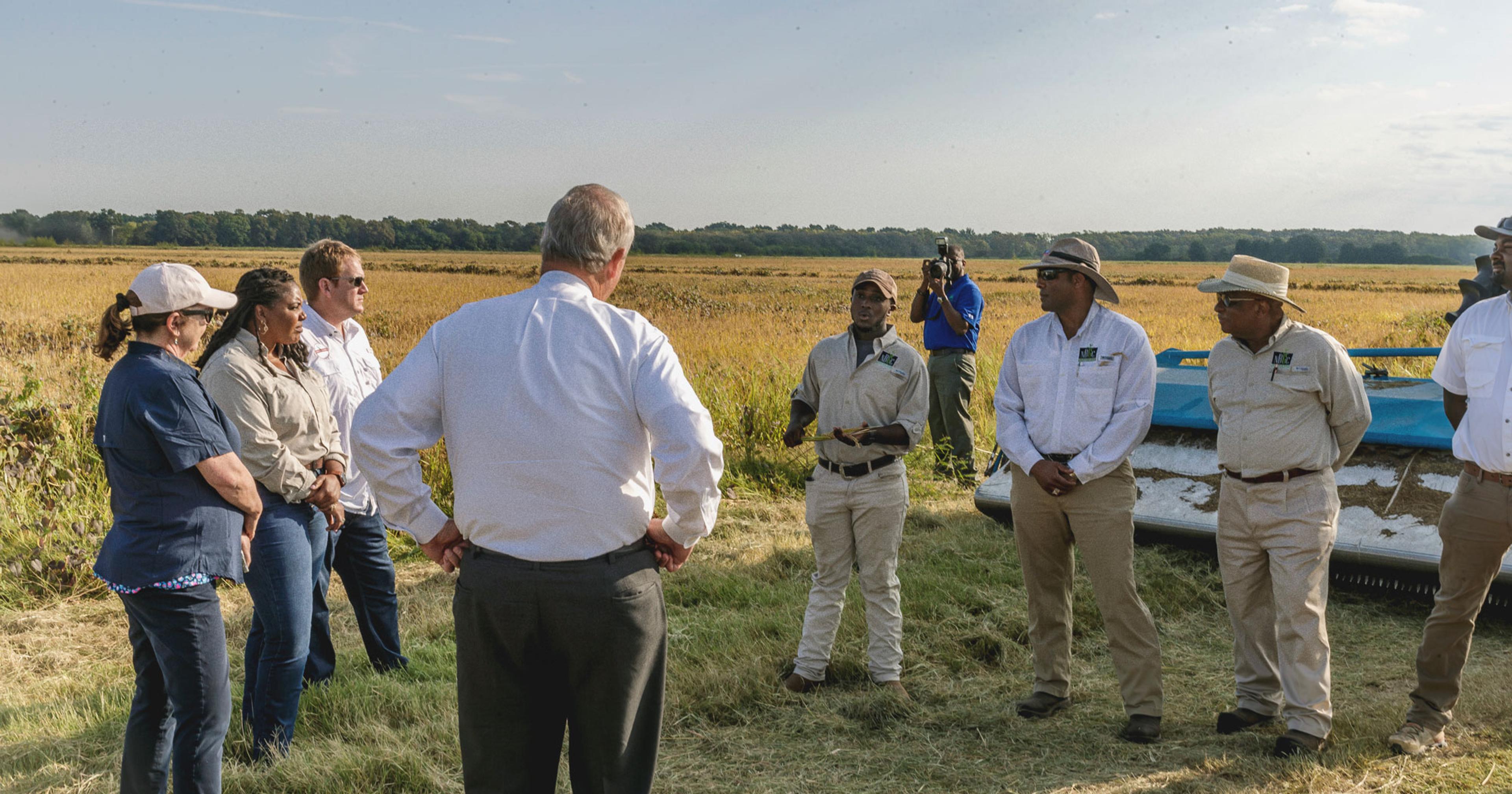A reintroduced bill in Congress might help with a shortage of meat processing plants. Experts say there’s a lot more to the problem.
Haywoods Fresh is a livestock farm in Upstate New York, producing grass-fed beef, natural pork, and pasture-raised chickens. They staff a stall every Sunday at a Brooklyn farmer’s market, but over the past couple of years, they’ve repeatedly had some version of this conversation with their regular customers:
“Can I have a package of pork chops?”
“We don’t have any today.”
“How about ground beef?”
“Nope.”
“Stew meat?”
“Sorry.”
The reason for the dearth is well-known to many small livestock farmers around the country. For at least the last two decades, and exacerbated by Covid starting in 2020, there’s been a shortage of USDA-certified meat processing plants where animals can be slaughtered and butchered into their various cuts. This has led to processing backlogs significant enough to threaten sales and the financial health of some farmers’ operations.
It’s also prompted calls to expand U.S. processing capability, particularly by upping the number of smaller processors who can serve smaller farmers. To wit: the Strengthening Local Processing Act, which is soon to be reintroduced by a bipartisan group of congresspeople and senators, led by Rep. Chillie Pingree (D-ME) in the House and Sen. John Thune (R-SD) in the Senate; both versions of the bill were first introduced in 2021.
If passed, the bill will attempt to solve for scenarios like the one that’s ongoing in the part of Columbia County, New York, that serves Haywoods Fresh; the processing pipeline can get so booked up that it can take months for farmers to schedule times to bring their animals in. The next-closest processor is too many miles away for easy animal transport — and it’s overbooked, too. The problem is hardly limited to Upstate New York, or even the Northeast. A recent report on Minnesota meat processing found a “severe lack” of poultry processors in particular in that state; “any processing plant closure can have consequences [that] radiate through local food systems,” the authors wrote.
This isn’t a new problem; federal agencies have been trying to fix it for years. USDA has offered various grants, loans, and other assistance programs that attempt to mitigate the situation, most recently with $223 million made available through the Biden Administration’s American Rescue Plan, which overall will invest $1 billion to expand “independent processing capacity” as a means to lessen consolidation in the meat industry.
As a White House press statement points out, the top four processors in beef, pork, and poultry control 85, 70, and 54 percent of their respective markets; they also saw record-high profits last year. This results in “food supply chains [that] are susceptible to shocks,” the statement reads. “When COVID-19 or other disasters such as fires or cyberattacks shutter a plant, many ranchers have no other place to take their animals. Our overreliance on just a handful of giant processors leaves us all vulnerable, with any disruptions at these bottlenecks rippling throughout our food system.”
“For all the USDA money that goes out every year, most of it goes to Big Ag.”
The proposed fixes (and wads of cash) sound great on paper. But Jon McConaughy, owner of a livestock farm in Hopewell, New Jersey, said it’s not that simple. “We all know that it’s needed but for all the [USDA money] that goes out every year, most of it goes to Big Ag,” he said. USDA money will only help “if it finds its way to where it needs to be” — in the hands of legitimately small operators.
The Pingree bill makes the case that where money needs to be is in communities. “Chefs, retailers, and consumers want to buy locally raised meat, and they’re frustrated by how difficult it’s become to get it,” said Pingree in a press statement; in fact, consumer interest in locally sourced meat has been growing since the pandemic began. On the flip side, livestock producer livelihoods “depend on having somewhere to take their animals” to meet this demand, “but under the current system, their options are severely limited.”
Provisions of the bill, if passed, would offer grants to existing small processors to help them expand, as well as to those looking to start new small facilities; it would also offer grants to boost training programs. (There’s an attendant shortage of butchers in the U.S.)
McConaughy is skeptical that the bill would achieve its intended purpose. He said that USDA, which would be responsible for distributing grant money, pays lip service to smaller farmers, even going “so far as to have a hotline for small producers. But they don’t have enough staff, which means it’s easier for them to get an inspector to a facility that’s got 20,000 hogs than one that’s got 10.” That means “there’s a disconnect between what the administration wants and how it’s implemented with USDA. They’re suffering from the same plight as most of the food industry, which is that it’s very, very hard to find labor.”
Rebecca Thistlethwaite is an extension outreach specialist at Oregon State University and director of its Niche Meat Processor Assistance Network. She also sat on the National Sustainable Agriculture Coalition committee that helped develop language for the Pingree bill. From processors she works with on the West Coast, she’s heard that the pandemic demand that led to meat processing bottlenecks has largely subsided — to the point where some processors are folding because they don’t have enough business. As a result, Thistlethwaite said she believes any new approach to assisting small farmers and processors “has to be a little bit different” than what the Pingree bill in its current form is proposing.
Farmers and ranchers must work to build markets for their product before adding more processors makes sense.
She’d like to see legislators create a “longer-term funding mechanism of ongoing small grants for both existing and startup processors,” she said, noting that there will come a time when the one-time grants and loans offered under the American Rescue Plan are tapped out. However, Thistlethwaite pushes back against the idea that merely expanding processing capacity will solve meat supply chain issues. Farmers and ranchers must work to build markets for their product before adding more processors to the mix makes any sense — something she educates producers about. “You don’t build manufacturing plants before you have contracts to buy those products, and the same is true for meat processing,” she said.
Thistlethwaite also emphasized the shortage of butchers to staff processing plants as a limiting factor. Researchers for the Minnesota report found that among the 57 processors they interviewed there was strong demand for financial help to offset the cost of training employees, and for offsite management skills training to happen in places like community colleges; the Pingree bill would create grants to support workforce training in these sorts of educational settings.
Here again, though, Thistlethwaite sees a problem. Young people don’t want “to work in manufacturing or processing or agriculture in any facet of it, unless they’re making TikToks about it,” she said. “I think a better opportunity there is to expand the agricultural visa program to include year-round [foreign] workers to work in processing,” as long as their rights are protected; and retraining willing packing plant employees as butchers.
McConaughy built one of only two USDA-inspected on-farm processing facilities on his farm. The benefit, he said, is “you have control of processing, there’s less stress for your animals, there’s increased flavor, there’s more flexibility, and you [don’t] have supply chain issues when there’s a disruption.” Such a model only makes financial sense if you process enough animals to offset the price of sending them to an offsite processor, though. The Pingree bill might theoretically help others like him to build such processing plants.
Still, McConaughy said USDA needs to ensure that small farmers receive money before it’s awarded to industrial-scale producers; and that information be made available to farmers so they can understand how to complete applications — he has no idea what he did wrong on his two grant applications for USDA to turn them down. “Make a grant-writer available, free of charge,” he suggested, “for anybody that wants to apply.”










